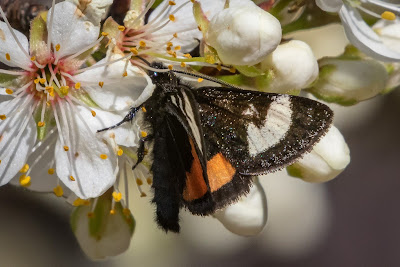 |
| Eight-spotted Forester nectaring on Mexican Plum |
As part of the larger groups of moths known as the Noctuidae and Thyrididae, Forester and Window-Winged moths are day fliers that commonly have white-spotted black forewings and either similar or bright orange hindwings, and are often found in open woodlands and flowery meadows. This time of year, you can frequently spot them nectaring on early blooming trees and shrubs, including Mexican Plum, Escarpment Black Cherry, Texas Redbud, and Mexican Buckeye.
 |
| A newly emerged adult Eight-spotted Forester |
In our area, the Eight-spotted Forester (Alypia octomaculata), Grapevine Epimenis (Psychomorpha epimenis), and Mournful Thyris (Pseudothyris sepulchralis) are the more typical species to be found. The Eight-spotted Forester has velvety black wings with two large cream-colored spots on each forewing and two large white spots on each hindwing, alluding to its ‘eight-spotted’ common name. It has a wingspan of about one and a half inches, and its legs are adorned with showy orange tufts where they attach to its body. Flying from March to June with a second brood in August, the larva of this moth have broader orange bands with black dots, alternating with fine black and white stripes, and an orange head and hind end. They feed mainly on Virginia Creeper and other various grapevines.
 |
| Eight-spotted Forester caterpillar |
 |
| Grapevine Epimenis nectaring on Mexican Plum |
Grapevine Epimenis is another Forester moth that also has velvety black wings, but each forewing has one bold white patch near the outer edge, and each hindwing has a broad orange-red band. With a wingspan of about one inch, it flies from February to April, and sometimes has a second brood in October. Its larva feed on various grapevines, most notably Mustang Grape in Central Texas, and are mainly black and white striped with an orange head and hind end.
 |
| Mournful Thyris nectaring on Mexican Buckeye |
Mournful Thyris is a Window-Winged moth, a chunky-bodied small moth with just under a one inch wingspan, that habitually spreads its wings when alighting on flowers or on wet sandy soils along forest trails. Its wings are black patterned with multiple various sized white spots, and translucent median patches that form ‘windows.’ It flies from February to April, and its larva also feed on grapevines, most commonly Mustang Grape in our area.
Contrary to popular belief, a surprising number of moth species are day fliers, and many are as beautifully patterned as, and often mistaken for, butterflies. If you’d like to attract these splendid little moths to your yard, simply plant the native trees, shrubs, and vines listed above, and they will grace you with their presence each spring!

